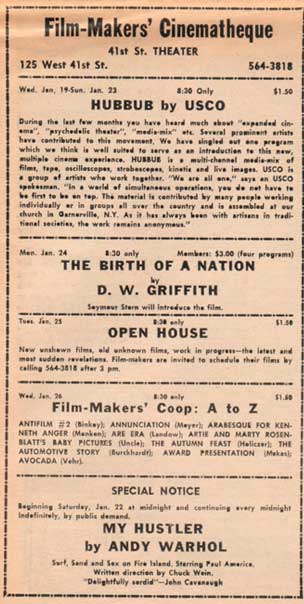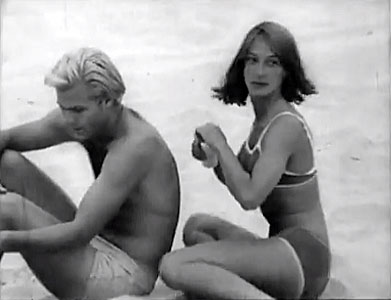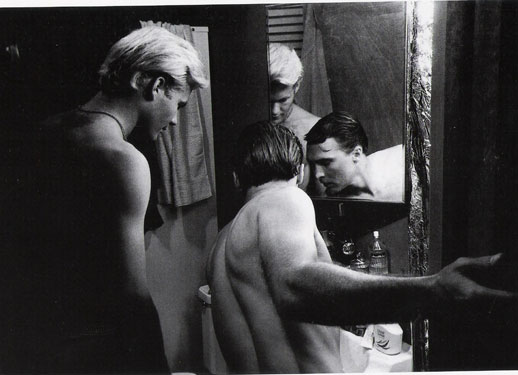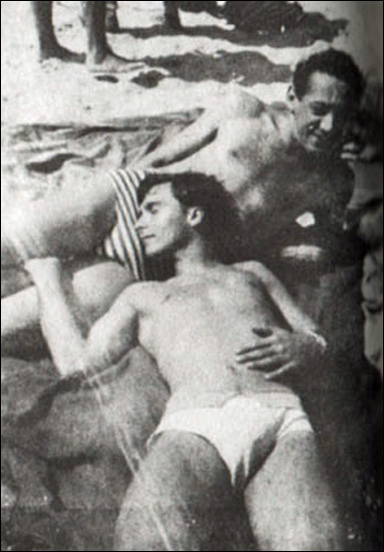to: Labor Day Weekend 1965: Andy Warhol Films My Hustler
Andy Warhol's My Hustler
by Gary Comenas
My Hustler was filmed on Fire Island on Labour Day weekend, 1965, according to Popism. Labour Day fell on September 6th in 1965.
The first advertisement for a screening of My Hustler appeared in the 6 January 1966 issue of the Village Voice for screenings on the 12th, 13th and 14th of January at 8 and 10 pm at the Cinematheque. At the time, the Cinematheque was then operating out of the 41st St. Theater (later known as the 42nd Street Cinema and, still later, as the New Cinema Playhouse - see Filmmakers-Cinematheque.)
The same dates are mentioned in the ad in the January 13th issue, and then on January 20th a "special notice" informs the reader that the film will play "every midnight indefinitely" due to public demand.

Village Voice ad, 20 January 1966
(https://warholfilmads.wordpress.com)
The Cinematheque ad in the following week's Village Voice also refers to midnight screenings of the film - on Wednesday to Thursday, January 26-27. But, after that, the ads don't mention screenings of the film until the 31 March issue of the Voice where it is advertised as playing Sunday April 3 and April 5 - 10. A poster advertised the film as playing April 3 to 10. It continued to be screened on and off at the Cinematheque over the next year and half. The last screening advertised in the Voice in 1966 was in an ad that appeared in the June 30th issue which advertised screenings on 4-7 July. After that, The Chelsea Girls became the main Warhol film shown by the Cinematheque until it (The Chelsea Girls) moved to more legitimate cinemas at the end of the year. My Hustler re-opened at the Cinematheque in April 1967 and finally opened at the Hudson Theater on 10 July 1967.
Mainstream movie reviewers had mostly ignored the film when it was screened at the Cinematheque but after it opened at the Hudson it garnered a review in the New York Times. Both the commercial success of The Chelsea Girls and the opening of My Hustler at a cinema outside of the underground film circuit probably played an influence in getting the movie reviewed in the Times. It was also reviewed in the Village Voice when it opened at the Hudson.
The Times review was headed "My Hustler Opens at Hudson: Warhol Work Made up of 2 Conversations." Bosley Crowther wrote in the review, "If Andy Warhol's My Hustler had to be shown hereabout any place outside the underground sanctum of the Filmmakers Cinematheque, it has found an appropriate showplace at the Hudson Theater, which has recently been edifying its patrons with burlesque and nudie film. For this minor chef d'oeuvre of Mr. Warhol, which actually predates both in production and original presentation his more notorious The Chelsea Girls, is a typical Warhol rendering of a homosexual strip-tease with words, and it seems quite congenial in the Hudson, where it opened yesterday for what is known in the trade as an exploitation run. (This was apparently encouraged by last winter's uptown success of The Chelsea Girls.)
Mr. Crowther ends his review by calling My Hustler "a come-on for curiosity seekers and voyeurs" and concludes that 'The Endless Conversations' would be a better title for this "fetid beach-boy film."
Andrew Sarris wrote a similarly negative review of the film in the Village Voice. Jonas Mekas, who headed the Cinematheque which had originally released the film, wrote a regular movie column for the Voice but it was Sarris who reviewed the film.
Andrew Sarris (The Village Voice, 27 July 1967, p. 17, 26):
"Andy Warhol's 'MY HUSTLER' (at the Hudson) is better heard than seen. It is reported that Chuck Wein wrote the viciously matter-of-fact conversations that accompany the epicene camera glimpses of a blond male beauty sunning himself on Fire Island's sand. The talk is outrageously funny and worthy of Restoration Comedy though lacking a moral or a raisonneur or dramatic action. This is the first movie in which I've heard the term 'fag-hag' used. Of course, the subject is laid on the line, and I doubt that even homosexuals are charmed by such brutal frankness. This is an ugly joyless movie. It is also anti-erotic despite its scabrous insertions. The underground has moved to the sexploitation circuit and the victims of sexploitation pay exorbitant prices to be punished for their erotic expectations. One kind of hustle is very much like another."
When Mekas had shown the film the previous year at the Cinematheque it was billed as as a "devastating scrutiny of socio-sexual mores" - a far cry from Crowther's characterisation of the film as "a homosexual strip-tease with words" or Sarris characterisation as an "ugly joyless movie."
It didn't help that, as Crowther pointed out, the Hudson Theater had previously been a venue for porn films. J.J. Murphy, Professor of Film at the University of Wisconsin and author of The Black Hole of the Camera: The Films of Andy Warhol, recalled seeing My Hustler at the Hudson in 1967:
J.J. Murphy:
"As a college student who attended the initial theatrical screening of My Hustler (1965), which played on a program with the black-and-white short Mario Banana #2, I can attest to the seediness of the viewing experience at the Hudson. After I passed through what seemed like a stained and filthy white cloth sheet that separated the actual theater from the lobby, my most vivid memory of seeing my first Warhol films involves the beams of that periodically emanated from the flashlight of a manic usher patrolling the aisles. These were aimed at viewers' crotches in order to insure that no one was masturbating. As far as I can remember, the audience was entirely male, and it was more likely the suggestive title rather than the Warhol name that drew most of them to the midtown theater. Yet, for all the flashlight action at the Hudson, My Hustler actually contains very little nudity." (JJM116)
Apart from Blue Movie, Warhol tended to intimate sex in his films rather showing it. Despite its salacious title, My Hustler consists mostly of conversations about a blonde hustler played by Paul America. Ed Hood's opening dialogue in which he berates his servant while watching Paul America sunbathing on the beach sets the general tone of the film:
Ed Hood (to servant):
"What are you doing out of uniform? When I hired you I hired you for purposes of servitude, and if this is what you call service or servitude, it's not a very good idea. You're totally out of uniform. I placed an ad saying I wanted a servant who understood discipline. By discipline I suggested boots, some knowledge of belts and leather, and you turn up in this garb. It's obvious that you haven't the least idea of what kind of servitude that I had in mind. You know what you were hired for? Never mind, it doesn't matter. Take a look around there and you will see a blond boy. Look out there. You see him? Now you're hired not only for servitude and discipline, but as my bodyguard. And that means that you have to take care of that boy too. Take care of him in every way that he requires, and he may require some very special ways. If he wants anything, you're to get it immediately. If, on the other hand, he presents any difficulties, you're to help me in taking care of him. You follow what I'm saying? All right then, get me some ice in this drink." (JJM117-18)
Hood bets his neighbour, played by Genevieve Charbin, and an "ex-hustler," played by Joe Campbell, that "neither one of you can make him and you can both try - of course you can't try too hard - you can't try everything - I don't want your clothes coming off Genevieve." Genevieve then goes down to the beach to try to seduce Paul by helping him with his suntan lotion while keeping an eye on Joe and Ed on the verandah.

Paul America and Genevieve Charbin on the beach in Andy Warhol's My Hustler
As is often the case with Warhol films, the real lives of the actors were as interesting as the roles they played. Often they played caricatures of themselves, regardless of what their actual role was in a film. Ed Hood was as camp in life as he was in the film and he tended to be attracted to young hustler-types in real-life as he was in the film. Hood also appeared in The Chelsea Girls with his underwear-clad friend Patrick Fleming who knew each other from having both lived in Boston. According to a relative of Patrick Fleming who contacted me in 2003, "Ed Hood was notorious for "drowning handsome young rockers with liquor and weed and taking advantage of them in a passed out state..."
Hood's co-star, Genevieve Charbin, later went on to marry Bennett Cerf's son, Christopher on 8 July 1972. In an article in the Palm Beach Daily News (11 June 1972) giving details of the bride-to-be, she is described as the daughter of the president of an international silk and velvet firm. According to the article, she attended Wellesley and has a B.A. in physics and astronomy, having "graduated magna cum laude and elected to Phi Beta Kappa." In 1975 People magazine proclaimed Genevieve and Christopher "the trendiest couple in America." Christopher Cerf was a regular contributor to Sesame Street, which he also helped to create, winning two Grammy awards and three Emmy awards in the process.
Max's Kansas City door person Dorothy Dean also makes an appearance in the film. She pops up at the end even though she's not been seen previously in it. She, along with Hood and Charbin, interrupt the older, ex-hustler giving Paul advice on how to turn tricks. The film ends with Dean's comment "Why be tied down to these old faggots?"
The ex-hustler is sometimes referred to in cast listings as the "Sugar Plum Fairy" - a euphemism for a drug dealer. Joe Campbell, who played the part, was the ex-boyfriend of Harvey Milk in real-life. He had met Warhol through Ondine (the Warhol star, not the discotheque) with whom he had been friends as a teenager in Red Hook, New York. (AD49)

Paul America (L) and Joe Campbell in Andy Warhol's My Hustler
Campbell first met Milk at Riis Park Beach in Queens, NY in July 1956. Joe was 19. Milk was 26. Campbell soon moved into Milk's Rego Park apartment and they lived together until late 1962 when Milk asked him to move out. After breaking up with Milk, Campbell looked up his old friend Ondine and eventually ended up in My Hustler. Milk eventually moved to San Francisco where he gained fame as the first openly gay man to be elected to the Board of Supervisors, only to be assassinated, along with Mayor George Moscone, in November 1978.
(http://sfpl.org/index.php?pg=2000186701)

Harvey Milk with a young Joe Campbell in the foreground, here
The star of My Hustler, Paul America, later gave an interview to the New York Times claiming that he hadn't been told what My Hustler was about at the time it was filmed and, in any case, he was on LSD the whole time.
Paul America:
"I was the male lead. But I was completely unaware of what 'My Hustler' was all about. They didn't tell me. I was on LSD the whole time, and I thought I was just going through some practice motions. It was shot in one day, and though we wanted to go back to Fire Island to finish it, we couldn't because there was trouble with the man who put up the money. We used his house for the movie, and it was destroyed - the furniture all torn up and burned in the fireplace. We were like little children in a playpen, or in a sandpit...
I got paranoid after making the movie. I was constantly on LSD and I saw cameras coming at me everywhere I went. Even the Con Ed men were shooting me from down in their manholes. It was that tiny bathroom that did it."
Although Paul America refers to "the man who put up the money," Paul Morrissey told Warhol biographers Tony Scherman and David Dalton that it was Dorothy Dean who put up the $500 that it apparently cost to make the film. (SC269)
After My Hustler, Paul America appeared in at least two unreleased sequels to the film and also made an appearance in Danny Williams' silent film Harold Stevenson.
Callie Angell:
After My Hustler, America appeared in a few other Warhol films from 1965: the unreleased sequels, My Hustler: In Apartment and My Hustler: Ingrid, and also Dan Williams' silent film Harold Stevenson, in which America, Gerard Malanga, Stevenson, Sedgwick, and others converse and drink wine while posing photogenically on a couch in a New York hotel suite. Another four-minute silent portrait of Paul America, shot on the beach during the making of My Hustler, has been found in the 'long version' of that film, in the edited montage by Dan Williams that was added to the sixty-six minute film in 1967. At the end of 1967, after a brief spell in the U.S. Army, America obtained some legal assistance and convinced Warhol to reimburse him retroactively for his role in the by-then commercially successful My Hustler; America reportedly received $1,000 in several instalments. That year America also starred with Edie Sedgwick in John Palmer and David Weisman's film Ciao! Manhattan (1967-71), but his role in the movie ended in 1968 when he was imprisoned in Michigan on drug-related charges." (AD26, 29)
In regard to the $1,000 paid in several instalments, as mentioned by Callie Angell, the 1967 New York Times interview with Paul makes reference to a payment of $500. In the article, Guy Flately writes, "Paul America, who skyrocketed to fame, if not fortune, in the title role of Andy Warhol's 'My Hustler,' recently rushed in where other superstars have feared to tread. With bullish determination - and a little legal assistance - he managed to hustle $500 out of Warhol for his performance as the naughty-but-nice beach boy in Andy's erotic epic... When Variety headlined this boffo bit of news, everyone from International Velvet to Mario Montez crumpled with shock." Paul is quoted in the article as saying, "I think Andy was always willing to pay, but somehow he was never there when I called, or it was 'come back tomorrow.' It's hard to be angry with him... he's so sweet, but he's... Andy. You can't argue with him and get him to write checks. He just 'oohs' and 'aahs' and calls in someone to take over the conversation for him." (GFL)
Although (as pointed out by Callie) Paul America appeared in a number of Warhol films, Warhol later remembered him as being only in My Hustler, and barely remembered that:
Andy Warhol, Andy Warhol Diaries, 6 July 1982):
"With the eclipse of the moon we got letters from the faithful nutty-letter writers, people like Joey Sutton and Crazy Rona. And Paul America called - I don't know from where - but the office has a list of 'Do Not Take Calls From' people so they didn't put the call through. And they said he was saying that he was one of my superstars, but he was never even in one of my movies. Oh wait! My Hustler! I forgot, (laughs) he was the star. He (laughs) was My Hustler." (AWD450)
According to Interview columnist (and sometimes editor), Bob Colacello, Paul had made a previous attempt, in about 1974, to contact Andy by visiting him in person at 33 Union Square West, but Warhol made a quick escape into the back office:
Bob Colacello (Holy Terror: Andy Warhol Close-Up):
"Paul America had been a silver-Factory Superstar. Tall, blond, and handsome, he had appeared in a single movie (like Valerie Solanas), playing the title role in My Hustler, shot on Fire Island in the summer of 1965. Now, nine summers later, he was back, pressing the buzzer at 33 Union Square West, an alumnus coming to call. He was buzzed in on the strength of his name, but the minute he came through the bulletproof door we knew it was a mistake. He was unrecognizable: huge, bearded, beer-belly, in overalls and faded flannel shirt, wild eyes roving until they met Andy's and locked into a terrifying stare, 'Oh, hi,' said Andy, 'gee.' Paul America stood there, staring. 'Oh,' said Andy gently, 'I'll tell Pat you're here.' He walked toward the back room as quickly as he could without running. Paul America stood there, staring at Andy's disappearing back, like a ticking time bomb. And then he turned and left. And Vincent shouted, 'You can come out now, Andy.'" (B233)
Paul America died on October 19, 1982 in Ormond Beach Florida after being hit by a car on his way home from a dental appointment. His My Hustler co-star, Ed Hood, was strangled to death by a real-life hustler in 1978. (FM427)
back to: Labor Day Weekend 1965: Andy Warhol Films My Hustler